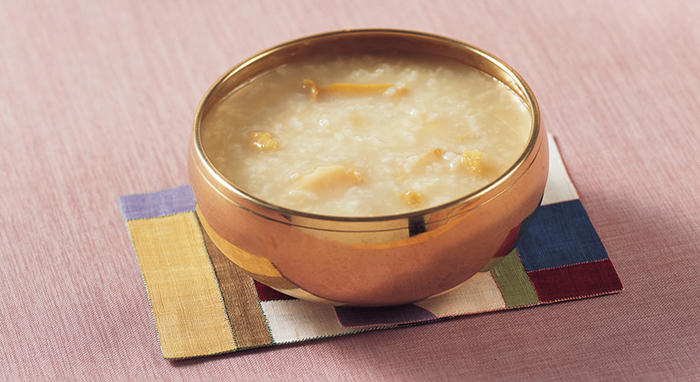View this article in another language
- 한국어
- English
- 日本語
- 中文
- العربية
- Español
- Français
- Deutsch
- Pусский
- Tiếng Việt
- Indonesian

Jeonbokjuk abalone porridge helps with recovering one's health. (Institute of Traditional Korean Food)
By Korea.net Honorary Reporter Nuran Sami from Egypt
Have you heard of the elixir of life, often times called the elixir of immortality? In ancient China, numerous rulers went after a kind of elixir amid beliefs of achieving immortality. One of those elixirs is abalone, which was reputed to be consumed most by the Chinese monarch Qin Shi Huang (r. 247 B.C.-220 B.C.). Eventually, abalone became an asset in old Korea, too, and an exceptional good that was bestowed upon the monarch and the royal court. Today, abalone porridge, or jeonbokjuk (전복죽), is perceived as the very item to offer someone who's sick.
Abalones can be prepared in raw slices, grilled, fermented and more. However, abalone porridge's basic ingredients are simply abalone and rice. The recipe is nutritious as it contains a rich amount of vitamins, proteins and minerals, like calcium.
The only way to achieve that profound ocean flavor when you prepare abalone porridge is to add the entrails. You can also season the entrails with vinegar and red pepper paste and mix them all with vegetables. Salted abalone entrails are a delicacy reserved for important guests.
It is noteworthy that Jeong Yak-jeon (정약전, 1758-1816), a Joseon scholar, introduced abalones in a book that he wrote in 1814, "Jasaneobo" (자산어보), which, interestingly enough, is the oldest record of marine life in Korea. The book depicts the attributes of over 150 different marine animals, including the appearances and usages of those animals. In his book, Jeong states that, "Abalone entrails can be boiled and salted.”
Personally speaking, I love to experiment and play around with ingredients to form a special type of broth and porridge. I could take a table spoon of corn water with a pinch of tikka spice powder and seaweed broth to finally use the results as a base for tofu, and it works wonders for my tofu craving. However, to have recipes with set rules to follow that you're certain are also followed by and engraved in the people of the recipe's homeland, it makes you feel a deeper connection to the taste and the thoughts or conditions that resulted in forming the named dish. Studying history and conceiving the atmosphere of its whereabouts then is fun, but it's a whole other level of cool when you can immerse in it with your senses for a moment, in this case, by tasting one of history's components!
wisdom117@korea.kr
* This article is written by a Korea.net Honorary Reporter. Our group of Honorary Reporters are from all around the world, and they share with Korea.net their love and passion for all things Korean.